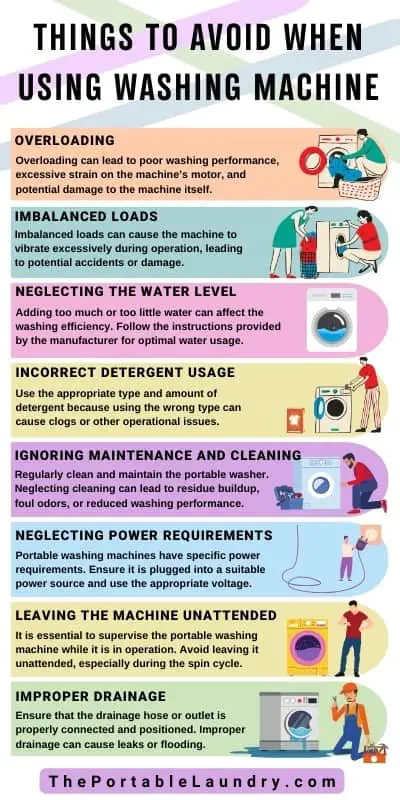A portable washing machine can save you time and money through its effective use. Most portable washers these days are extremely efficient.
To use the machine, first, make sure that your hands are dry to avoid any electric shock or mishap.
Simply follow the below steps to wash your clothes efficiently.
Table of Contents
Hookup the washer
The first step is to hook up the washer.
Ignore the below steps if the washer is already hooked and proceed to the next step i.e., Fill up the laundry.
- Choose a spot near a water source, such as a sink or faucet, and a drain, and ensure that the surface is stable and level.
- Gather the necessary supplies i.e., you will need a Portable washing machine, Hoses (Typically, portable washing machines come with hoses for both water intake and drainage), Faucet adapter (Check if your faucet requires an adapter to connect the washing machine hose) and a power source (Ensure the washing machine is near an electrical outlet).
- Connect the water intake hose.
- Locate the water intake valve on the portable washing machine.
- Attach one end of the water intake hose to the valve.
- Connect the other end of the hose to the faucet (Use the appropriate adapter if necessary).
- Connect the drainage hose.
- Locate the drainage outlet on the washing machine.
- Attach one end of the drainage hose to the outlet.
- Place the other end of the hose in a sink, bathtub, or another drainage area. Ensure it can drain properly without causing any spills or flooding.
- Plug in the washing machine
READ: How to hookup a portable washing machine?
Fill up the laundry
First of all, load your washer with an appropriate amount of clothes. Before that, you must read the instructions manual that contains information about how many clothes can the washer contains.
Usually, machines can hold up to 10 pounds.
Separate the clothes based on color and fabric type in the same way you used to do in a normal washing machine.
READ: How to Hookup a portable washing machine?
Soak for some time and leave it
If any piece of cloth needs special attention or has tough stains, you must presoak it for some time to soften the dirt.
Use some stain remover that not only takes care of the color of the fabric but also removes the stains faster without any damage.
Most portable washers these days also have a soak mode so you can just soak the clothes inside the washer or can use any tub or bucket if you want.
READ: How to wash a Down-Jacket in the washing machine?
Connect the washer to the faucet
It contains an inlet hose that is to be connected to the tap to fill up the machine tub with water and an outlet hose that drains the water.
Follow the instructions mentioned in the booklet to connect the hoses to the machine body. Use a wrench to make them fit tightly.
Some troubles may occur at the first trial.
Fit the hose with the sink tap, if it doesn’t fit, you can purchase an adapter and make it work.
The best fit is when there is minimum water leakage from the nozzle. When the nozzle is being fixed, move on to fixing the drainage pipe.
READ: What is RPM in Washing Machine?
Put the drainage pipe in the sink
Insert the drainage pipe appropriately into the sink’s hole and fix it in such a way that it does not slip out of the sink and flood the floor.
READ: 14 Things you shouldn’t wash in your washer
Turn on the water
You must leave the faucet on for the entire washing cycle. You can use hot water or cold water according to your need. For other casual dresses, use cold water and for undergarments, towels and, food sheets, you can use hot water.
READ: What is Soil Level in Washing Machine?
Switch your machine on
Place the plug into an electric point and switch it on.
If the electric point is not near, use an extension cable but it is not recommended because portable washing machines work best when connected directly to the plug.
Press start after clicking out your laundry mode and size.
Almost all machines have a timer that provides you with the benefit of deciding how long you wish to wash your clothes.
The more the clothes are dirtier, the longer should be the wash time.
When switched on, the washer will at once start taking in the water.
READ: How to Clean Mold from Washing Machine?
Use an effective detergent
Some portable washers do not contain detergent containers, so just spread the detergent into the flowing water to avoid clumping the powder. But you must acknowledge that liquid detergents or high-efficiency detergents work best with portable washing machines because they mix well.
For one laundry cycle, a half cup of detergent is sufficient to work. Lastly, ensure that you add a liquid fabric softener.
READ: Top Load VS Front-Load Detergents
If the machine needs, rinse again
Some machines do not require a rinse cycle but if your machine does, then fill the washer with clean cold water and let it rinse. You will have to drain it again when the rinse cycle is completed.
READ: Can Vinegar Damage a washing machine?
Detach the hose when the cycle is completed
Close the tap when the cycle is completed and wait for a while to ensure that the pipe has drained out all the water.
Now remove the hose from a faucet and leave it for some time to let it drip dry.
READ: 20 Answers you must know about Laundry Pods
Let the clothes dry
The clothes have been dried by the spin cycle but make sure to hang them.
In summer, you can hang them on your porch or terrace so that the sun waves can make them dry. Whereas in winter, hang them on a drying rack.
The drying rack provides more space for the clothes to let them dry and it occupies less space itself.
READ: 6 Things you must know about Washing Machine Bearings
Keeping the portable washing machine
First, after using, place the hose inside the tub of the washing machine to avoid any water spilling out.
It is really heavy despite its small space but it can be kept easily in a closet or in the corner of the bathroom or even the kitchen.
For the better health of a washer, it is important to clean your washer periodically.
So try to run the washer empty with some cleaner or bleach after every six months to remove any bacteria or dirt or even the soup buildup.
You can find a detailed guide to cleaning your portable washing machine here.
READ: The Ultimate Guide to Storing Your Portable Washing Machine
Common mistakes to avoid when using washing machine

Overloading the machine
Avoid overloading the portable washer beyond its recommended capacity.
Overloading can lead to poor washing performance, excessive strain on the machine’s motor, and potential damage to the machine itself.
Note: Follow the manufacturer’s guidelines for load size.
Imbalanced loads
Ensure that the load inside the machine is distributed evenly. Imbalanced loads can cause the machine to vibrate excessively during operation, leading to potential accidents or damage.
If necessary, redistribute the clothes to achieve balance before starting the washing cycle.
Neglecting the water level
Pay attention to the recommended water level for each load.
Adding too much or too little water can affect the washing efficiency and even damage the machine. Follow the instructions provided by the manufacturer for optimal water usage.
Incorrect detergent usage
Use the appropriate type and amount of detergent specified for portable washing machines. Using excessive detergent can lead to excessive sudsing, which may overflow or damage the machine. Additionally, using the wrong type of detergent can cause clogs or other operational issues.
Forgetting to secure the machine
Ensure that the portable washing machine is placed on a stable and level surface.
Some models may have a locking mechanism or suction cups to secure the machine in place during operation.
Double-check that the machine is securely positioned to prevent it from tipping over or moving unexpectedly.
Neglecting power requirements
Portable washing machines typically have specific power requirements.
Ensure that the machine is plugged into a suitable power source and use the appropriate voltage and wattage as specified by the manufacturer.
Avoid using extension cords or power outlets that are not rated for the machine’s power needs.
Ignoring maintenance and cleaning
Regularly clean and maintain the portable washer as per the manufacturer’s instructions.
Neglecting cleaning can lead to residue buildup, foul odors, or reduced washing performance.
Follow the recommended cleaning schedule and procedures to keep the machine in optimal condition.
Leaving the machine unattended
It is essential to supervise the portable washing machine while it is in operation.
Avoid leaving it unattended, especially during the spin cycle.
This precaution ensures that any unexpected issues or emergencies can be addressed promptly, reducing the risk of accidents or damage.
Improper drainage
Ensure that the drainage hose or outlet is properly connected and positioned.
Improper drainage can cause leaks or flooding, leading to potential slip hazards or damage to the surrounding area.
Follow the instructions provided by the manufacturer to set up the drainage system correctly.
Using the machine for non-approved items
Do not wash items that are not recommended for use in the portable washer, such as shoes, large blankets, or heavy items.
These items can potentially damage the machine or cause operational issues.
Stick to washing lightweight garments and fabrics within the machine’s specified guidelines.
How to Choose the Right Cycle Settings on Your Portable Washing Machine?
Choosing the right cycle settings on your portable washing machine involves a few key considerations:
Fabric Type: Different fabrics require different treatments. Refer to the fabric care label for guidance. Delicate fabrics usually need a gentle cycle, while sturdy items like towels can handle a more robust cycle.
Soil Level: Adjust the cycle based on how soiled the clothes are. Lightly soiled garments may only need a quick cycle, while heavily soiled ones might require a longer, more intensive cycle.
Cycle Type: Common cycle types include normal, delicate, quick wash, and heavy-duty. Delicate cycles are suitable for fragile fabrics, while heavy-duty cycles are ideal for items like jeans and linens.
Water Temperature: Some cycles allow you to adjust water temperature. Hot water is effective for removing stains and germs, while cold water helps prevent colors from fading and saves energy.
Spin Speed: Faster spin speeds extract more water, reducing drying time. Delicate fabrics benefit from slower spins, while sturdy items can handle faster spins.
Additional Options: Some machines offer extra options like pre-soak, extra rinse, and steam. These can be useful for specific situations.
Time and Efficiency: Quick cycles save time, but longer cycles might be more thorough. Balance your need for speed with the desired level of cleanliness.
Final Thoughts
Using a Portable washing machine is extremely easy and most of them come with detailed instructions on how to use it.
The bottom line is portable washers do save a lot of time and it easily fits into small apartments.
Furthermore, it’s pocket friendly and easy to maintain.
Read: Portable Washers: How They Work & their working principles
If you still have further queries related to connection or anything related to portable washers, there are high chances we might have addressed that in our Portable Washer’s FAQ Section.
Frequently Asked Questions
What is a portable washing machine?
A portable washing machine is a small, compact washing machine that can be easily moved and used in different locations. Some portable washing machines even have wheels and handle for easy transportation and are powered by electricity or batteries. Portable washers are smaller in size and capacity than a traditional washing machines and are often used in small apartments, RVs, or as backup machines.
What to look for in a portable washing machine?
When looking for a portable washing machine, consider the capacity, spin speed, wash cycles, ease of installation, water consumption, and electricity consumption of the model. Additionally, look if the washer has compatible hoses to fit into your sink. Lastly, features such as automatic shut-off, and a delay start function can be good to have features.
Do you leave the water on for portable washing machine?
Ideally, you should leave the water on until the washer completes the cycle. So, depending on what you wash, the wash cycle duration and the water consumption may vary.
How much detergent do I put in my portable washer?
Read the user manual and the instructions on the detergent label to strike the right balance. As a general rule of thumb, use less than what’s recommended in the instruction label on the detergent package.
What do I need to hook up a portable washing machine?
In most cases, your portable washer will come with the required fixtures. However, in some cases, you may need to get an after-market hose as the standard ones provided with a washer may not be long enough. So, you will need a drain hose, a water inlet hose, and a power cord in order to hook up your portable washer.
Can you manually add water to a portable washing machine?
Technically, you can add water to a portable washing machine. However, it’s best to get your washer connected to a water source as it may need to drain and fill to complete the set cycle.
You May Also Like
- How to hook up a washing machine? (Explained)
- What is a Lint Filter in Washer? (10 Things you must know)
- Are washing machines waterproof on the outside?
- How to keep the washing machine in a small bathroom?
- How do you clean the washing machine agitator?
- Why does the sink gurgle when the washing machine drains?
- How to get rid of the smell in Washing Machine?
- How to Calculate Washing Machine Capacity? (With formula)
- What causes a washing machine motor to burn out? (Detailed Explanation)
- Does LG make portable washing machines?
- How to bypass the water level sensor in washing machine? (Easy Steps)
- Where do you put the detergent in a Speed Queen?
- How to fix no power and no light issue on Washing Machine?





